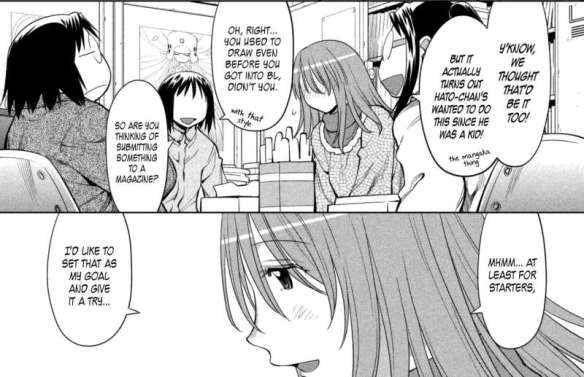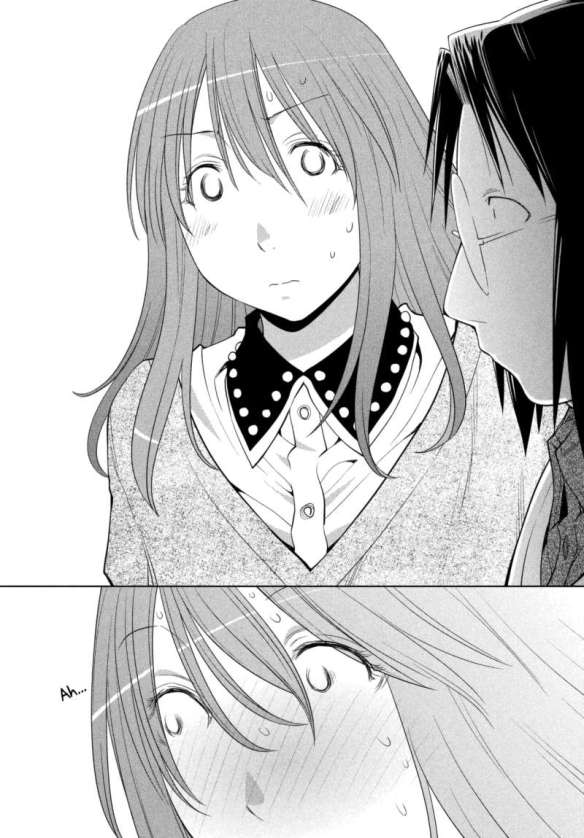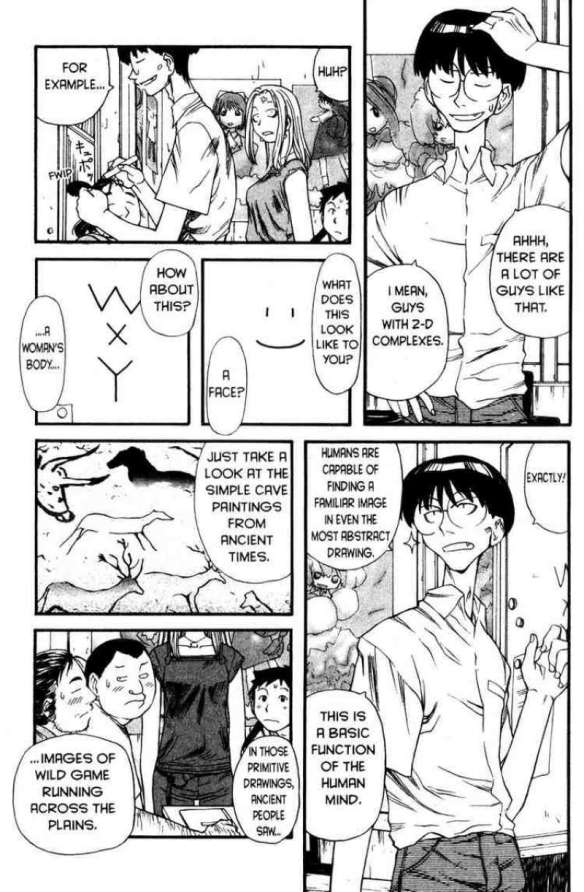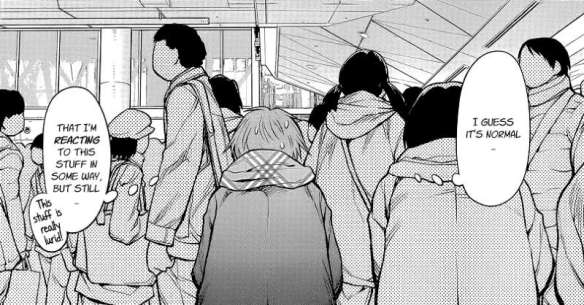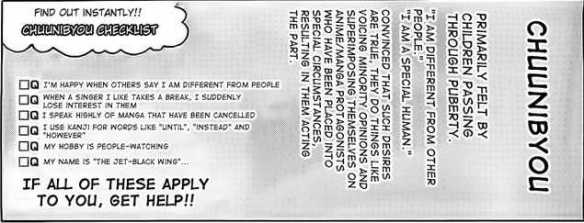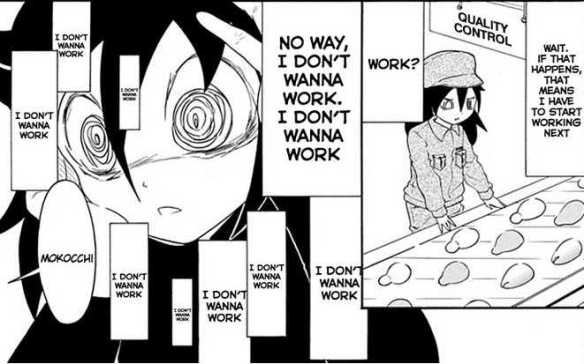It is difficult to write this, so bear with me. I was scanning the feed on Academia.org, which lead to an article at the TWC Journal, which led to another article about (wtf???) Iron Man x Captain America slash (apparently a very big thing in the West and in China – who’d ‘ave thot..), which led to An Archive of Our Own and then the folder of Genshiken -urrrm- fanfiction. It is difficult to write this because what left of my honor as a middle-aged cis straight male compelled me to try to gouge my eyes out after a cursory reading.
So I exaggerate; it didn’t kill me.
I didn’t try to gouge my eyes out in a fit of ‘phobic guy hysteria. I didn’t even blush. I blame Genshiken and this blog. (I award myself two adult maturity points, take back one for the eye gouging intro gambit) I saw a lot of care and concern in the writing, even though it didn’t work for me. A few of the stories activated my clunky prose warning light, but that also made me recall the ancient and venerable words of slash-kami Alias Mary Jeanne Johnson about fanfiction, and what the heck, it keeps ’em out of the pool halls.
Oh heck, I over-quote this one in too many posts, so this time, more of it:
“…And there’s a third detail that needs addressing here. Fantasies are nothing if not personal. The yaoi writer is writing what turns her on- what satisfies her – what consoles her. A reader isn’t really necessary. You didn’t want to hear that, did you? But it’s a fact. Yaoi is a personal fantasy, written primarily to satisfy the writer’s kinks and those who share those kinks. Like porn. Other people can come and read it, no doubt, but if they don’t share that kink, they might as well go away again. The story isn’t written for them.
Yaoi isn’t like other fictional writing. It’s a private vision written for personal satisfaction, and to apply the standards by which we judge ordinary literature to yaoi is to willfully ignore this private element. You can say ‘Male pregnancy stories don’t do it for me’ if you like, but to say ‘Male pregnancy stories are stupid and childish and people should stop writing them’ is not only arrogant, it’s dangerous. All fantasies are legitimate or none are, and to discredit the male pregnancy fantasy is automatically to discredit your own fantasy of mutual empowerment and non-penetrative sex. As for trashing a fanwriter’s style, it’s like shooting the piano player. Chances are she’s doing the best she can. The only way you get to play the piano better is by playing the piano more. And quite possibly she writes that way because she likes writing that way, typos and all, and belongs to that huge group of people (of whom Word’s Spell-check is one) who really believe that its should be written it’s on all occasions.”
– The Top Ten Things I Love About Yaoi , Oct, 2001 by M.J.Johnson, Aestheticism.com (site archived at:)
http://web.archive.org/web/20080820030543/http://www.aestheticism.com/visitors/editor/jeanne/10_things/index.htm
Perhaps this is too reasoned and calm a defense of the personal for our troubled times. A bit more anger makes the point too:
“So they place unfair expectations on what you create. Tell you it’s too short, too ugly, too personal, ask you why it doesn’t resemble what already exists. And the answer is, why would we want it to?
They impart the subtle idea that a handful of geniuses are born and the rest clean up after them.
They want us to believe that our thoughts are not worth voicing.
How the fuck is life worth living if the brains we have right now aren’t good enough?
The audience/performer dynamic as it exists is built on capitalism, on academia, on a proper way of doing things defined by people who do not have our best interests at heart and indeed don’t care if we live or die.
Like I wrote here, “Under our capitalist system, to accept other ways of communicating is to devalue the cash value of the communication style learned in college.”
They don’t want your stories because the idea that someone can tell a story without going to college or someone can make a game for free is a betrayal of capitalism, it’s a betrayal of an industry that says creativity can only be imparted for money.
People are taught to believe they aren’t someone. Taught to believe they aren’t a Creator. Not an Artist, not an Intellectual. No one is taught that more than minorities.”
– Creation Under Capitalism and the Twine Revolution, November 25, 2012 Porpentine , a game creator.
I stand corrected, – scratch the pool hall comment.
My clumsy compare and contrast exercise is presented only to drive home the point that if Kio Shimoku ever chooses to slam Hato-chan (or kun) and Madarame-sempai together, it should be an epic tale of comedic fail. Far more fraught than a late-night brush with Keiko’s charms. I now await the train wreck; it must at least measure up to fan attempts. What the few slash fics I sampled glossed over in their hurry to bring direct resolution to certain longstanding tensions in the Genshiken epic is how massively inept, hesitant and pathologically skilled at avoidance and self delusion both Madarame and Hato (kun, chan and fan posited josou-game otomeyaku variants) are. A steamy ending is by no means guaranteed
Faced with an emotionally uncomfortable moment Madarame would first try to run, then if cornered would start dissembling in planet Otaku-speak at 200 wpm. Hato meanwhile would turn beet red and start yammering on about pairings, though he may also instinctively take Mada’s enthusiastic waving gestures as a threat and shoulder-throw him. It is inevitable. Poke armadillos and they roll up into a balls. They have been so constructed for a reason – which if tracked back far enough probably involves Kio Shimoku’s mortgage.
(Btw, don’t you think that Poke Armadillos would be a great name for a band?)
One Ao3 writer had an interesting, if under-developed angle. Madarame, if driven to fits of uncontrollable lust, would try to act out the ero bits of josou games. Hato would go from what he read about weirdly improbable yaoi lust techniques. Much clumsy pawing would ensue. Those little mentions were funny as heck and could have been dragged out for many, many more laughs. I advise Shimoku -sensei to start with at least a case of beer (no, not for him, for the nervous couple) and be aware of the comedic possibilities of classic pratfall slapstick.
As if he needs my advice.
I wonder if any Japanese fan-fiction writers are writing Genshiken fanfiction and how they are writing it. A few smutty dojin are scanlated but he imaginations of the fans for whom the work is written for remain tantalizingly obscured from our view. Ao3 works are all “diaspora” artifacts.
A question for the slash-writers: where are all the Heart of the Wind and Trees and Thomas high melodramatic declarations and emotionally bits? The Cliffs Notes say these are important to the genre. Perhaps less so for the Western variant? I feel a bit let down. The chorus from Ao3 chides me that if I have ideas, I should put up or shut up, but I don’t want to start writing Genshiken slash, (Oy Veh!) so my opinion doesn’t count.
I will say that Usotsuki Lily does a fine job with fantasy cross-dressed characters without falling into josou game inspired otokonoko ecchi-ness. The mangaka Ayumi Komura went as far as to try some real-life 3D cross-play at some of her book signings – so while her critters are still complete fictions, she at least dipped her toes into it. Apparently her fans loved it. So what if Lily gets a bit preachy…
Stop straw-dogging the fan-fiction writers. Time to prod the mangaka.
Viewed in the light of fannish fun or teachable moment shoujo romances, Kio Shimoku is playing it very, very safe. Presumably the tastes of his readers reflect approval of this as well as some kind of climate-of-the-times effect. Genshiken has evolved from being a mildly transgressive comedic effort that skewered Otaku foibles to something closer to a comforting slice of life “safe space” for grown-up post-Otaku.
This isn’t a bad thing in itself, but I am wondering if this is a case of “not much is being done with it“, or something else?
The contrast between what Genshiken could do and is doing is not just pointed out be fannish fiction. Enthusiastic scanlator types have of late resurrected some mighty odd 1980’s and 1990’s examples of “non-traditional sexualities in domestic settings” comedies and slice-of-life potboilers. One would expect these to be clumsy and politically incorrect as all heck. Surprisingly enough, they are not too vicious. They often verge on the considerate. They are bitingly funny in parts. Someone so inclined might even be tempted to rehabilitate them as proto-queer fiction for some academic grist-mill, even as they remain rock steady in adopting a cisgendered straight male POV. Blah blah blah… Academic fads invariably slide so sideways that they end up in “I am the Eggman territory”
Set the Way-Back Sherman; we are going to visit some slightly transgressive historical manga:
Stop! Hibari-Kun! is frightenly politically incorrect and with its 1980’s drawing style an even odder read. Hisashi Eguchi‘s Hibari-kun (note the lack of Butlerian “presenting” concerns here) is the only son of a proud, though somewhat inept yakuza family. He has hit upon a sure-fire way to avoid the responsibilities of taking over the family business. He likes being a girl a lot more than he likes the idea of being a proper young male thug and boss-in-training. When the orphaned son of Pop’s old flame comes to live with the family, Hibari Oozora decides that Kousaku Sakamoto is just too much fun to leave alone and that they both should attend high school together. Naturally, Hibari-chan insists on attending as a girl. Hijinks Ensue.
Hibari is probably a prototype for a slew of comedy- of- gender- identity manga (and anime) that followed and it remains enjoyable because it writes Hibari as having almost superhuman sang-froid, competence and good, though mischievous nature. Hibari-chans just wanna have fun. Most everyone else around who would threaten his hobby/ inclination are over-the-top idiots, except his adopted step brother, who gets to be the goat during most of the ensuing chaos. Hibari may aspire to femininity, but her ideal feminine is a younger and richer version of Fujiko Mine. Hibari is a slightly queer-er and slightly more criminal predecessor to Kuragehime‘s Kuranosuke Koibuchi. As the manga progresses, the characters who take a longing interest in Hibari-chan become odder and odder. When the slavering moron son of a rival yakuza clan becomes fixated (said creature being too developmentally challenged, in a nasty way of course to even be smitten) on Hibari and yakuza Dad proves unable to fend off its slimy father’s attempts to coerce compliance by threatening Kousaku, Hibari goes into full metal Mine mode
When a very severe bifauxnen sports star heartthrob at high school suddenly develops uncomfortable feelings of longing for Hibari-chan… to play on her volleyball team, we even get some light yuri steam. A subsequent glimpse at the bifauxnen’s home life is over the top burlesque; too silly to even call out as insulting. Having Mom as a Taka otoko-yaku who insists on practicing her Rhett Butler routine at home is a stroke of genius. I should also mention the Village People dance line of brothers… Jeesh!
Not at all shabby for a 1980’s effort. The whole thing was re-released to an anniversary edition a few years ago – I have a feeling that it must be some kind of minor cultural artifact.
Odder still is the 1990’s Family Composition/ Family Compo or F.Compo (1996-2000) by Tsukasa Hojo. This is the most earnest heteronormative gender-bent family slice of life story I have stumbled across since the last stories of R.A.Heinlein. Love (and an independent income gained through professional skill and hard work) conquers all. Tsukasa Hojo is also known for the long-running City Hunter, Angel Heart and Cat’s Eye (co authored with Rieko Fukuda) series.
Oh heck, cue the TV tropes synopsis:
“Ordinary college student Masahiko goes to live with his aunt and uncle, Yukari and Sora Wakanae. While excited about meeting his relatives for the first time, he is surprised to discover that his lovely aunt Yukari is actually male and his handsome uncle Sora is physically female. Their plucky daughter, Shion, is revealed to be… whichever gender she feels like (Though for the time being she’s sticking with female).
However, given Masahiko’s current fate: living alone in a fetid apartment that he can’t afford and with no family to return to: he decides to stay anyways. Eventually, Masahiko’s desire for a real home coincide with the Wakanaes’ surprising generosity to anyone who is willing to accept their family at face value, and he quickly becomes Happily Adopted into the household.
By the mangaka Tsukasa Hojo, Family Compo is a Slice of Life manga that, perhaps, is a more realistic than average depiction of trans* sexuality, and at the same time has a remarkably positive tone with tremendous emotional poignancy.”
— http://tvtropes.org/pmwiki/pmwiki.php/Manga/FamilyCompo
The artwork is striking in a retro way; It verges towards comic book “realism”, or at least a more detailed style than is the norm today. Moe-free zone ahead! Once you get over the odd premise that a trans man and a trans woman (both pre-op, though both are hinted to have undergone hormone treatments, the trans woman mom, Yukari breast augmentation procedures) would settle down to maintain a boringly sweet and conventional household and raise an upright, high-achieving (most of the time, lately) daughter, you can read a story with plot lines would do Laura Ingalls Wilder proud.
The daughter, Shion is the most interesting character in the whole story. Genderfluid, or verging on post-gendered at first, her final challenge to Masahiko is a reassuringly pure 1950’s man-up = get the girl challenge. Even as it is also gets the girl to decide to be a girl.
Because this is a 1990’s artifact there is a lot of blur between trans-folk, crossdressers, gay folks of various stripes and gender dysphoria issues. Everybody so concerned ends up either at the Wakanae household or at a seedy crossdressing gay bars. Of note is that the nightlife is not portrayed as an evil in itself; only as an inadequate substitute for a fantasy “normal” (DAB inverted) domesticity. There is also plenty of crossdressing, both for identity and tourism reasons which mixes up transvestite, gay and transsexual identities, but the Wakanae household is so happily kumbaya supportive that it doesn’t really matter much. The second floor is also uncle Sora’s manga studio and the assistants are a comic-relief mob of bent DMAB gals, each with their own reasons for wearing dresses. They are the closest thing to an insulting stereotype in the story, but reserve their alcohol fueled “Surprise! It’s a Trap!” man-chasing forays for rude-boys who come on too strong towards “real” females. And Sora in manga-deadline mode is fearsomely serious. Disturb at your peril. Get back to work!
Sooner or later most characters get gender-bent a bit. Before long Masahiko is wheedled into crossdressing for his University film club and the next thing you know a yakuza boss smitten with him. Some plot turns later and the delinquent son of the same yakuza boss ends up living at the Wakanae house, but it turns out delinquent son started out life as a girl and is really over-compensating. He hates everyone; male and female and most of all himself. Yakuza dad tries to do right by the youth and means as well as a noble thug type can manage, but needs to ease off and give his now-son some space. The yakuza mom is a bitter piece of work, a classic scheming feminine betrayal engine but eventually even she shows a tiny shred of parental concern. Love conquers all. I should also add that the entire artifact is almost completely devoid of fanservice and that there are no sex scenes.
The only recurring motif appears to be that in a choice between your child’s needs for understanding, compassion and support and obeying the rules and strictures of society, one had best chose the child and damn the rest the to the fire.
Given some of the grim news in the real world of late, this is very good advice.
The only character who really gets short shrift is Masahiko’s long-suffering girlfriend. She is convinced that any straight male who sets foot in the Wakanae household is going to end up queered and bent either to crossdressing male gayness or an awakened trans* identity (which never seems to be same-sex attracted in the F-compo universe). The stuff must be contagious. Masahiko is too wishy-washy and is of course also attracted to Shion, but can never get up the nerve to ask and/ or directly confirm what genitalia Shion has, so he cannot acknowledge his feelings and/or break it off with girlfriend. Girlfriend finally dumps him for a more traditionally manly man childhood friend, leaving him to get over his little problem with whether Shion is or isn’t or if it even matters, or does any attraction feel a bit incestuous now that he’s living under their roof? Yikes!
Shion of course is there to shift the goalposts of the whole game – her parents encouraged her be whichever gender she wanted as she grew up, (and yes, it is pretty well intimated that Shion was deemed female at birth and remains biologically female-bodied) so the whole gender role thing is a bit of a needless complication for her. Towards the end, she begins to consider that it might be necessary though, in order to develop any romantic feelings for anyone. Mostly she doesn’t sweat too much about any of it. Besides, she, (at college he) wants to be a film director – so who has time? Shion’s radical indeterminacy is possibly the most interesting component of the series.
Moral of the story: Your gender identity is important, but so is developing a creative skill-set that will let you earn enough money to make your dreams possible – unless you aspire to become a perfect trans woman housewife to a trans man professional. Oh, and “inverts” (to use the dreaded archaic sociology term) make the best partners for each other.
Hmmph!
More Hmmph: While Compo looks like its author did a bit of research, the trans-folk portrayed within as well as all the other non-het characters were and remain cartoon creations; “fantasies of crossdressing” to borrow a term from Nagaike. They, like Hibari-kun were whomped up by straight guys for comedy, posing a few questions about gender and sexuality and advancing a few pleasing nostrums while selling manga. As imagined others/ imagined other sexualities, they fall prey to the same complaints leveled at fantasy yaoi puppets, fantasy yuri puppets and Kenjiro Hato, They pose far more questions than they purport to give easy answers for.
We are back to Chip Delany’s quip “if gay men and women didn’t exist, straight men and women would have had to invent us.” …And my previous rejoinder.
Aside from a tour of retro queer-ish Japanese manga, I bring these up in contrast to the current story-line in Genshiken. For now, Kenjiro Hato’s little problem (or enthusiasms) look bland when compared to the neighbors. So do Madarame’s. Yawn! On the other hand, no one in the Genshiken is having family problems and what Family Compo, and to a lesser extent Hibari-kun are about are families, so perhaps a compare and contrast exercise is a bit of off.
The best moments of Family Compo are when Uncle Sora has to return home to face his angry patriarchal father with wife and children in tow. This stuff is of course a gender-bent variant on the classic Japanese theme of family duty, which is still a big seller in today’s Japan.
Watch this mini documentary [http://vimeo.com/114879061] on Japan’s second oldest onsen and note the daughter’s quiet plight. This is right out of the pages of Compo, mirroring the Girlfriend‘s situation (or perhaps the filmmaker can’t resist pinning a comic book plot on a real-life setting?).
Only with Kuchiki (perhaps soon Yajima??? All things considering, Rika’s folks are saints) do we see any hint of family pressure in the Genshiken-verse. Hato’s family is a cypher; all the tension is so far limited to his brother and sister-in-law to be. How did they react to their son’s ostracism at high school? Do they know of his enthusiasms? Genshiken members’ families are the classic absent parents of late-modern Japan.
Another note: the fictional trans-continuum characters of these early comics are nothing like the even odder fantasy Josou/ otokonoko/ third sex creatures that sprung from ero games in the latter years of the ‘aughts. They were not built for male-gaze moe. The otokonoko character may well be a stealth retread of an older rotten-girl pairing archetype, introduced into the male pr0n fan community to wreak havoc on hetero-normality, but it bears little resemblance to its crossdressing manga predecessors that were more for comedy and gender tourism. Genshiken’s Hato X Mada X Hato dynamic is firmly set in the current 2007-2015 archetype-verse.
Aside re: the “That’s a bit obscure” rejoinders by Madarame to Sue’s initial Bakemonogatari references. In Genshiken-time only the light novels were available. In the real-time of serialization, the anime was current. As a fan and a friend of the Bake cabal, a shout-out was irresistible, but Kio Shimoku used to worry about situating his universe in a coherent time-frame. Less so now.
One further small thread of analysis to be tugged at: the quick trip with the Wayback Machine seems to point to a profound shift in manga storytelling conventions that has been brought on by the parallel evolution of games and visual storytelling. I wish I was more of a game person, but even my cursory experience seems to suggest that the effect is powerful, almost inescapable. Especially from dating-sims, eroge, otome games and the like. The references are unavoidable, as are the shorthand posited by the conventions of these games for interactive behavior among characters.
Often lampshaded for extra comedic effect, they turn every poignant, difficult moment between characters into a mechanistic, alienated exchange.
More Symptom or Condition of The Fall than aid to the shy, tongue-tied character, they increase isolation while invalidating the communication that they propose to aid. Of course their ironic use has its moments of genius.
.
“It is not up to you to determine who you are. It is up to the people around you..”
Since New Year’s eve at the public bath, the current Genshiken members plus Keiko, Angela and Kousaka have made it clear that they are aware of Hato’s tentative you-and-only-you feelings towards Madarame. Hato knows that they know. Madarame and Kuchiki are out of the loop; we can assume that Tanaka gets filled in later. Hato’s nadeshiko power-up after returning from home must be taken as a sign that he intended to follow up on the idea. Soon there are all the dinners for Mada, until… Hato finds a new thing to obsess over. Some crush. Seduced and abandoned! No Hato coming by means no Sue either, except for the one weird visit with the mask and handcuffs. I guess Mada’s virtue is once again safe!
Nine more years and Mada will get Wizard status!
Here is an odd thought: Spotted flower is not only where Kio Shimoku plays Red Dwarf double-double universe, it is also where he turns off the liminality field that smothers and yet propels so much of the Genshiken tale. The last two omake out have older Hato and Yajima analogues as friends, working a winter and then a summer Comiket. The entire purpose of theses two two-page shorts seems to be to blatantly telegraph: “yes analogue-Hato went on the be a mangaka and live as a trans person, yes she got breast augmentation surgery, but kept the boy bits below and yes she still hangs out with analogue-Yajima, who while supportive, will still chide analogue-Hato even more than she used to chide analogue-Rika.”
The uncertainty from the previous “meeting” chapter is reduced. Decisions have been made.
The new “safe-space” Genshiken seems to be more about not deciding if it hurts. After all, who says that a decision is mandatory? The fans? The mangaka-gami? Society? Religion? Manga Studies Departments syllabii? Tv Tropes? Some Blog?
“What happens to the daughters of these housebound women in the suburbs? Have they turned into the yaoi girls who are the consumers of the cute boy images and their erotic stories? The participants of the otaku debate unanimously agree that in this context gender difference is asymmetrical. The girls who do not want to repeat the Mothers’ life have two choices; to embody their time-frozen images as a little girl in order to get men’s attention, or to live in the liminal space between such images and their own bodily actuality.”
– Rio Otomo: A Girl with the Amoebic Body and her Writing Machine
https://web.archive.org/web/20120609085942/http://coombs.anu.edu.au/SpecialProj/ASAA/biennial-conference/2006/Otomo-Rio-ASAA2006.pdf
In a time when real world conditions conspire to inexorably choke off and limit choices, perhaps the indeterminacy of the Genshiken was overlooked and undervalued, even by fans like me. It is ok, Genshiken critters; you don’t have to resolve if you don’t want to. There is comfort and support in that too.
Be safe and happy.


![genshiken_nidaime_8.mkv_snapshot_15.59_[2013.09.03_13.03.02]](https://heartsoffuriousfancies.files.wordpress.com/2015/01/genshiken_nidaime_8-mkv_snapshot_15-59_2013-09-03_13-03-02.jpg?w=600&h=338)

![genshiken_nidaime_8.mkv_snapshot_06.13_[2013.09.03_12.50.53]](https://heartsoffuriousfancies.files.wordpress.com/2015/01/genshiken_nidaime_8-mkv_snapshot_06-13_2013-09-03_12-50-53.jpg?w=612&h=344)










![genshiken_nidaime_8.mkv_snapshot_09.56_[2013.09.03_12.55.47]](https://heartsoffuriousfancies.files.wordpress.com/2015/01/genshiken_nidaime_8-mkv_snapshot_09-56_2013-09-03_12-55-47.jpg?w=600&h=338)




